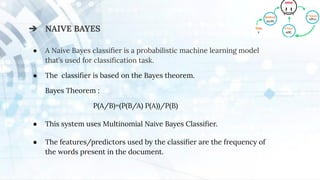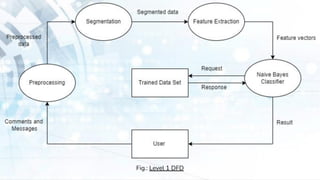CYBERBULLYING DETECTION USING MACHINE LEARNING-1 (1).pdf
- 1. CYBERBULLYING DETECTION USING MACHINE LEARNING PRESENTED BY GROUP I Under the Guidance of Ms.Surya Ashok, HOD Computer Science department TEAM MEMBERS: ANITHA R KRITHIKA V S MEGHA M S PRANIDHI K J
- 2. ABSTRACT ● With the widespread use of social media in this era, cyberbullying increased rapidly as a cybercrime. ● Cyberbullying is a willful and repeated harm inflicted through the use of computer, cell phones, and other electronic devices. ● The proposed system aims at detecting cyberbullying, it detects abusive comments and messages in social media platform. ● The Machine learning algorithm,Naive bayes is used to classify comments and messages as bullying and non-bullying. ● The project ‘Cyberbullying Detection Using Machine Learning’ discusses and implements the approach of machine learning in order to solve the threat of cyberbullying, and thus makes social media a safe place for the users.
- 3. SYSTEM SPECIFICATIONS Hardware Specification Processor : Intel Core i5 Speed : Above 1GHz RAM capacity : 4GB or above Hard Disk Space Required : 5 GB or above Keyboard : Standard Keyboard Mouse : Standard Mouse Monitor : Standard color monitor
- 4. Software Specification ● Language Used : Python 3.10, HTML5, JavaScript ES6 ➔ Here, HTML and JavaScript are Used for designing the web application. ➔ The main advantages of using python in this project is that it is open source. ➔ It also has vast built-in machine learning libraries available. ● Web Framework : Django 3.7 ➔ Django is preferred in this project because of its simplicity, flexibility, reliability and scalability. ● Database : SQL Server 2019 ➔ SQL Server 2019 (15.x) introduces new ways to work with SQL Server Containers such as Machine Learning Services. ➔ Supports Query interleaving,which is a tabular mode system configuration that can improve user query response times in high-concurrency scenarios.
- 5. EXISTING SYSTEM ● For several years, the researchers have worked intensively on cyberbullying detection to find a way to control or reduce cyberbullying in Social Media platforms. ● In a research work by Massachusetts Institute of Technology, a system to detect cyberbullying through textual context in YouTube video comments was developed, but the system showed less precise classification outcome and increased false positives. ● Generally most existing systems are focused on effects after cyberbullying incident and there is no accurate system for online cyberbullying detection.
- 6. PROPOSED SYSTEM ● The proposed system employs machine learning to avoid human intervention. ● A dataset containing cyberbullying and non-bullying comments is used to train the machine learning model using the Sklearn library in Python. ● Naive Bayes algorithm is used for detecting abusive comments and messages in social media.
- 7. ● The Naive Bayes algorithm states that: P(A/B)=(P(B/A) P(A))/P(B) ● In the proposed system automated detection of bullying comments in social media is implemented. ● The proposed system is platform independent, it can be implemented on any operating system and it is free to use.
- 8. MODULE DESCRIPTION ● User module. ● Admin module. ● Machine learning module.
- 9. MODULE FUNCTIONALITIES ❏ USER MODULE ● Users can sign up to the web application by registering themselves by providing details like user name,password etc.. ● Registered users can also sign in to their profile by using user id and password. ● They can post videos,stories and photos in the web application. ● Users can send friend requests to other users and can also chat with their friends. ● Users can view,like and comment the videos and photos posted by their friends in the web application.
- 10. ❏ ADMIN MODULE ● Admin can handle and make changes in the web application. ● They can also view the requests from users . ● They can also view the comments that have been classified as bullying and non-bullying. ● They can manage the notifications of users.
- 11. ❏ MACHINE LEARNING MODULE ● The Machine Learning module is responsible for classifying comments and messages as bullying or non-bullying. ● From a vast set of comments and messages, the Naive Bayes algorithm is used to predict bullying comments and messages. ● This module includes the following steps : ➢ Data collection ➢ Data preprocessing ➢ Segmentation ➢ Feature extraction ➢ Training ➢ Testing
- 12. FLOWCHART OF CYBERBULLYING DETECTION SYSTEM
- 13. 1. DATA COLLECTION ● Collecting data for training the Machine Learning model is the basic step in the machine learning pipeline. ● The predictions made by Machine Learning systems can only be as good as the data on which they have been trained. ● In this system, dataset containing bullying as well as non-bullying comments and messages. ● The data set is downloaded from KAGGLE website. ● 80% of dataset is used for training and the remaining 20% is used for testing.
- 14. 2. DATA PREPROCESSING ● Real-world raw data and images are often incomplete, inconsistent and lacking in certain behaviors or trends. They are also likely to contain many errors. So, once collected, they are pre-processed into a format the machine learning algorithm can use for the model. ● Data preprocessing in Machine Learning is a crucial step that helps enhance the quality of data to promote the extraction of meaningful insights from the data. ● The proprocessing step also includes the removal of stop words, special characters and the conversion of uppercase letters to lowercase. ● The Lemmatization step includes converting tense word into root word. For example, the word running is converted to its root word run.
- 15. 3. SEGMENTATION ● Segmentation can be defined as the process of separating sentences into different tokens. ● N-grams are used for grouping tokens. ● N-grams are used for a variety of things. Some examples include auto completion of sentences. ● In this project, 2-gram is used to group tokens.
- 16. 4. FEATURE EXTRACTION ● Feature extraction is the process of taking out a list of words from the text data and then transforming them into a feature set which is usable by a classifier. ● In this system, TF-IDF vectorizer is used for feature extraction. ● TF-IDF stands for term frequency-inverse document frequency and it is a measure, used to quantify the importance or relevance of string representations in a document. ● TF-IDF associates each word in a document with a number that represents how relevant each word is in that document.
- 17. 5. TRAINING ● Model training is the key step in machine learning that results in a model ready to be validated, tested, and deployed. ● The performance of the model determines the quality of the applications that are built using it. ● Quality of training data and the training algorithm are both important assets during the model training phase. ● Typically, dataset is split for training and testing. ● All these aspects of model training make it both an involved and important process in the overall machine learning development cycle.
- 18. 6. TESTING ● In machine learning, model testing is referred to as the process where the performance of a fully trained model is evaluated on a testing set. ● The testing set consisting of a set of testing samples should be separated from the both training and validation sets, but it should follow the same probability distribution as the training set. ● Each testing sample has a known value of the target.
- 19. DOMAIN THEORY ➔ Machine learning ● Machine learning (ML) is the study of computer algorithms that improve automatically through experience. ● Machine learning involves computers discovering how they can perform tasks without being explicitly programmed to do so. ● The Machine Learning process starts with inputting training data into the selected algorithm. ● New input data is fed into the machine learning algorithm to test whether the algorithm works correctly.
- 20. ➔ NAIVE BAYES ● A Naive Bayes classifier is a probabilistic machine learning model that’s used for classification task. ● The classifier is based on the Bayes theorem. Bayes Theorem : P(A/B)=(P(B/A) P(A))/P(B) ● This system uses Multinomial Naive Bayes Classifier. ● The features/predictors used by the classifier are the frequency of the words present in the document.
- 21. CONFUSION MATRIX Fig : Confusion Matrix
- 23. POST MESSAGES
- 25. DATA FLOW DIAGRAMS Fig. : Level 0 DFD
- 26. Fig.: Level 1 DFD
- 27. Fig.: Level 1 DFD of user
- 29. LEVEL 1.1 DFD OF ADMIN
- 30. ER DIAGRAM
- 31. ADMIN LOGIN
- 32. ADMIN HOME PAGE
- 33. SIGNUP PAGE
- 34. LOGIN PAGE
- 35. HOME PAGE
- 36. WARNING MESSAGE
- 38. CONCLUSION The overall aim of the project “Cyberbullying Detection Using Machine Learning” is to develop a system that automatically classifies comments and messages as bullying or non-bullying and also remove the bullying comments from the web application.
- 39. BIBLIOGRAPHY Referenced Sites: 1. Cynthia Van Hee, Gilles Jacobs, Chris Emmery, Bart Desmet, Els Lefever, Ben Verhoeven, Guy De Pauw, Walter Daelemans, Véronique Hoste, Automatic detection of cyberbullying in social media text, PloS one 13 (10), e0203794, 2018 2. Sweta Agrawal, Amit Awekar, European conference on information retrieval, Deep learning for detecting cyberbullying across multiple social media platforms, 141-153, 2018 3. Ong Chee Hang, Halina Mohamed Dahlan 2019 6th International Conference on Research and Innovation in Information Systems, Cyberbullying lexicon for social media, (ICRIIS), 1-6, 2019 4. John Hani, Mohamed Nashaat, Mostafa Ahmed, Zeyad Emad, Eslam Amer, Ammar Mohammed, Social media cyberbullying detection using machine learning, Int. J. Adv. Comput. Sci. Appl 10 (5), 703-707, 2019






































